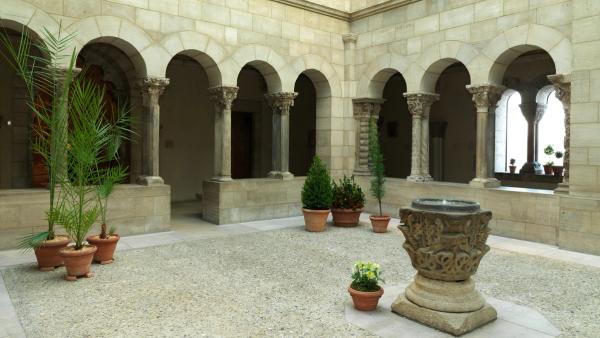Saint-Guilhem Cloister
The capitals attest to the skill and imagination of the medieval sculptor. Many imitate the leaf forms of ancient Roman types; others appear as if covered by vines, and one precisely represents the form of a hops plant. Still others present stories from the Bible, including Daniel in the Lions' Den. Inventively carved columns and pilasters imitate the bark of a palm tree, cascades of water, or clusters of foliage.
In the wake of the French Revolution, many elements of the cloister were acquired by local citizens. The elements seen here were purchased by the American sculptor George Grey Barnard before World War I.
The late eleventh-century limestone capital in the center (25.120.246), recut as a font, comes from the Auvergne or Guyenne region of France.
Artwork Details
- Title:Saint-Guilhem Cloister
- Date:late 12th–early 13th century
- Culture:French
- Medium:Limestone
- Dimensions:30 ft. 2 in. × 23 ft. 10 in. (919.5 × 726.4 cm)
- Classification:Sculpture-Architectural-Stone
- Credit Line:The Cloisters Collection, 1925
- Object Number:25.120.1–.134
- Curatorial Department: Medieval Art and The Cloisters
Audio

Saint-Guilhem Cloister
Gallery 3
NARRATOR: The screen of columns in this room comes from a monastery in France called Saint-Guilhem-le-Désert. Turn to your left and walk along the row. You'll notice that the shafts of the columns take a variety of shapes: cylindrical, faceted, and wave-like. They offer a fine introduction to medieval sculpture. To see what I mean, continue through the arcade to the place where you can pass between the columns, and look at the pair immediately on the left. *
Look at the inverted bell shape that crowns these columns: it’s called a capital. The leaf decoration is just what you might find on an ancient Roman capital, carved a thousand years before these. But if you look above the leaves at the rectangular block, you'll find features without ancient precedent: the curling vine resembles a grapevine, but instead of grapes, there are human heads, each with its own hairstyle and facial expression. The twelfth-century sculptor responsible could have completed his commission without this level of inventiveness; and yet he produced this variety, it would seem, out of pure creativity. It's worth noting too that nature was his springboard: the capitals of many columns in this cloister show foliage of some kind. Most of the leaves and vines are not botanically recognizable, but one is: it's hops, the basic ingredient in beer, and an essential commodity in the medieval economy.
Listen to more about this artwork
More Artwork
Research Resources
The Met provides unparalleled resources for research and welcomes an international community of students and scholars. The Met's Open Access API is where creators and researchers can connect to the The Met collection. Open Access data and public domain images are available for unrestricted commercial and noncommercial use without permission or fee.
To request images under copyright and other restrictions, please use this Image Request form.
Feedback
We continue to research and examine historical and cultural context for objects in The Met collection. If you have comments or questions about this object record, please contact us using the form below. The Museum looks forward to receiving your comments.
